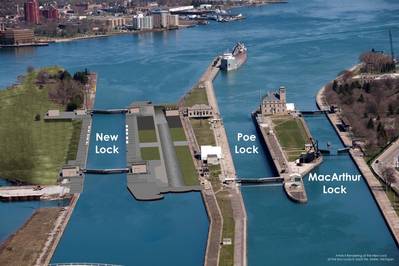New Lock at the Soo Reauthorized in WRDA 2022 at $3.219 Billion
U.S. Army Corps of Engineers, Detroit District New Lock at the Soo Project in Sault Ste. Marie, Michigan is reauthorized in the Water Resources Development Act (WRDA) 2022 on Dec 23, 2022. The project reauthorization amount is $3.219 billion.
An authorization sets how much money agencies and programs can receive, and how they should spend the money. This authorization makes it possible for the project to maintain efficient funding eligibility. Due to recent cost increases, the project cost was estimated to exceed the previously authorized spending limit.
“With continued funding, the remaining construction work, valued at $794.5 million could be awarded over the next three years allowing the project to stay on schedule and be completed in 2030.” Deputy District Engineer Kevin McDaniels said.
Since the project’s authorization in America’s Water Infrastructure Act of 2018, the authorized cost changed from $922 million to $3.219 billion. Over the last four years, the project cost has been impacted by labor shortages, supply chain disruptions and material cost increases.
The Corps of Engineers sought consideration of an increased authorized project cost in WRDA 2022 by transmitting the approved Post Authorization Change Report to the House and Senate Authorizations Committees on June 8, 2022. The project received strong bipartisan support while going through both the House and Senate.
The Soo Locks are situated on the St. Marys River at Sault Ste. Marie, Michigan and allow vessels to transit the 21-foot elevation change at the St. Marys Falls Canal. Over 88 percent of commodity tonnage through the Soo Locks is restricted by vessel size to the Poe Lock. This new lock project will construct a second Poe-sized lock (110' by 1,200') on the existing decommissioned Davis and Sabin locks site.
A 2015 Department of Homeland Security study estimates a six-month Poe Lock closure would temporarily reduce the U.S. gross domestic product (GDP) by $1.1 trillion, resulting in the loss of 11 million jobs. This Great Lakes Navigation System critical node is essential to U.S. manufacturing and National Security according to the study.














